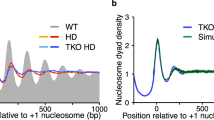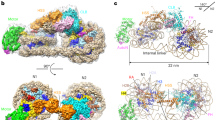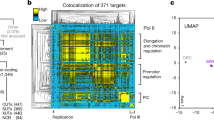Abstract
The structure of the nucleosome core particle, the basic structural subunit of chromatin, is well known1. Although nucleosomes often appear to be positioned randomly with respect to DNA sequences, in some cases they seem to occupy precisely defined positions on the DNA2–8. The yeast plasmid TRP1ARS1 contains three precisely positioned, stable nucleosomes, I, II and III, which are flanked by nuclease-sensitive regions.5 Our aim in the present study was to determine whether the positions of these three nucleosomes relate to (1) protein–DNA interactions; (2) the limited space between nuclease-sensitive regions, which is just long enough to accommodate three yeast nucleosomes (that is, boundary conditions9); or (3) proximity to the putative origin of replication in one of the nuclease-sensitive regions5,10. We have tested these alternatives by analysing the positions of nucleosomes after insertion of various lengths of DNA into this region and assembly of chromatin in vivo. Our results suggest that specific protein–DNA interactions are the most likely determinants of these nucleosome positions.
This is a preview of subscription content, access via your institution
Access options
Subscribe to this journal
Receive 51 print issues and online access
$199.00 per year
only $3.90 per issue
Buy this article
- Purchase on Springer Link
- Instant access to full article PDF
Prices may be subject to local taxes which are calculated during checkout
Similar content being viewed by others
References
Richmond, T. J., Finch, J. T., Rushton, B., Rhodes, D. & Klug, A. Nature 311, 532–537 (1984).
Igo-Kemenes, T., Hoerz, W. & Zachau, H. A. Rev. Biochem. 51, 89–121 (1982).
Bloom, K. S. & Carbon, J. Cell 29, 305–317 (1982).
Wu, C. Nature 286, 854–860 (1980).
Thoma, F., Bergman, L. W. & Simpson, R. T. J. molec. Biol. 177, 715–733 (1984).
Nedospasov, S. A. & Georgiev, G. P. Biochem. biophys. Res. Commun. 92, 532–539 (1980).
Cartwright, I. L. et al. CRC crit. Rev. Biochem. 13, 1–86 (1982).
Varshavsky, A. J., Sundin, O. H. & Bohn, M. J. Cell 16, 453–466 (1978).
Kornberg, R. Nature 292, 579–580 (1981).
Tschumper, G. & Carbon, J. Gene 10, 157–166 (1980).
Simpson, R. T. & Stafford, D. W. Proc. natn. Acad. Sci. U.S.A. 80, 51–55 (1983).
Varshavsky, A. J., Sundin, O. H. & Bohn, M. J. Nucleic Acids Res. 5, 3469–3478 (1978).
Lohr, D., Kovacic, R. T. & Van Holde, K. E. Biochemistry 16, 463–471 (1977).
Strauss, F. & Varshavsky, A. Cell 37, 889–901 (1984).
Author information
Authors and Affiliations
Rights and permissions
About this article
Cite this article
Thoma, F., Simpson, R. Local protein–DNA interactions may determine nucleosome positions on yeast plasmids. Nature 315, 250–252 (1985). https://doi.org/10.1038/315250a0
Received:
Accepted:
Published:
Issue Date:
DOI: https://doi.org/10.1038/315250a0
This article is cited by
-
Chromatin structure of the 5′ flanking region of the yeastLEU2 gene
Molecular and General Genetics MGG (1989)
-
A consensus transcription termination sequence in the promoter region is necessary for efficient gene expression of the TRP1 gene of Saccharomyces cerevisiae
Molecular and General Genetics MGG (1988)
-
Another folding problem?
Nature (1987)
-
Analysis of nucleosome arrangement on satellite DNA of rat liver chromatin
Journal of Biosciences (1987)
-
Bent DNA at a yeast autonomously replicating sequence
Nature (1986)
Comments
By submitting a comment you agree to abide by our Terms and Community Guidelines. If you find something abusive or that does not comply with our terms or guidelines please flag it as inappropriate.



